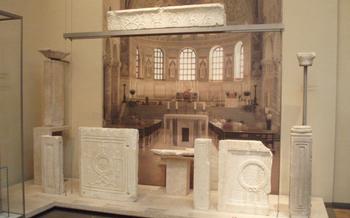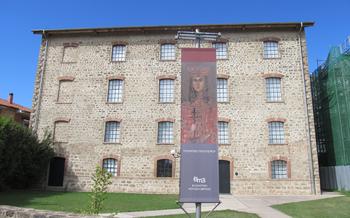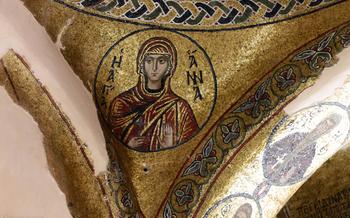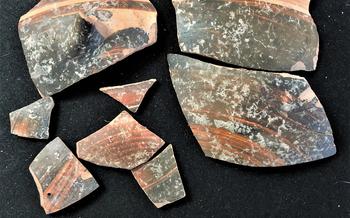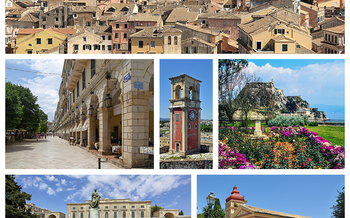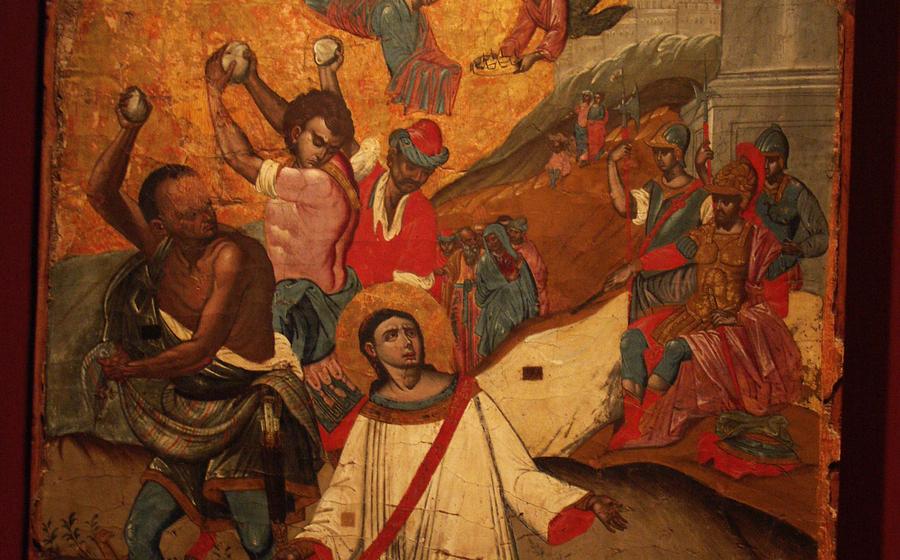
Byzantine Museum of Antivouniotissa
- History of the Byzantine Museum of Antivouniotissa
- Location and Accessibility
- Architectural Marvel
- Permanent Collection
- Temporary Exhibitions
- Byzantine Icons
- Frescoes and Mosaics: A Testament to Byzantine Artistry
- Manuscripts and Books
- Textiles and Vestments
- Ceramics and Pottery
- Metalwork and Jewelry:
- Guided Tours:
- Museum Shop and Café:
History of the Byzantine Museum of Antivouniotissa
The Byzantine Museum of Antivouniotissa, nestled in the heart of Corfu, Greece, stands as a testament to the rich cultural heritage of the Byzantine Empire. Once a humble monastery dedicated to the Virgin Mary Antivouniotissa, the building underwent a remarkable transformation in the 1970s, becoming a sanctuary for preserving and showcasing Byzantine art and artifacts. The museum's mission is not only to safeguard these precious relics but also to promote the understanding and appreciation of Byzantine culture among visitors from around the world.
The Antivouniotissa Monastery, founded in the 13th century, played a significant role in the religious and cultural life of Corfu. Over the centuries, it amassed a collection of invaluable Byzantine icons, manuscripts, and other treasures. Recognizing the importance of this heritage, the Greek Ministry of Culture transformed the monastery into a museum in 1970. This decision marked a new chapter in the preservation and promotion of Byzantine art in Greece. Today, the Byzantine Museum of Antivouniotissa stands as a beacon of cultural enlightenment, inviting visitors to delve into the fascinating world of Byzantine artistry and spirituality.
Location and Accessibility
The Byzantine Museum of Antivouniotissa is conveniently situated in the heart of Corfu Town, just a short walk from the bustling main square, Spianada. To reach the museum, visitors can take advantage of the city's well-connected public transportation system. Several bus lines, including the No. 2, No. 5, and No. 6, stop within a short walking distance of the museum. For those arriving by car, limited street parking is available in the surrounding area. Alternatively, visitors can park at the Public Parking Garage, located a few minutes' walk from the museum, which offers ample parking spaces at a reasonable rate.
Architectural Marvel
The Byzantine Museum of Antivouniotissa stands as an architectural masterpiece, seamlessly blending the grandeur of Byzantine design with modern architectural elements. The building's exterior facade captivates visitors with its intricate stone carvings, arched windows, and a majestic entrance that invites them into a realm of rich history and culture.
Upon entering the museum, one is awestruck by the soaring ceilings, supported by elegant columns that create a sense of spaciousness and grandeur. The harmonious fusion of Byzantine and modern architectural styles is evident in the use of traditional materials like stone and marble, juxtaposed with sleek glass panels and contemporary lighting fixtures.
The museum's design is not merely aesthetic but also functional, ensuring that visitors have an immersive and engaging experience. Natural light floods the galleries through strategically placed windows, illuminating the exquisite artifacts and creating an ambiance that enhances their beauty. The layout of the museum is well-thought-out, guiding visitors through a chronological journey of Byzantine art, with each gallery leading seamlessly into the next.
The Byzantine Museum of Antivouniotissa is not just a repository of priceless artifacts; its architectural design is an integral part of its storytelling, creating a space that transports visitors back in time and allows them to fully appreciate the splendor of Byzantine artistry and craftsmanship.
Permanent Collection
The Byzantine Museum of Antivouniotissa houses a remarkable permanent collection of Byzantine art, offering visitors a glimpse into the rich artistic heritage of the Byzantine Empire. The collection encompasses a wide range of artifacts, including icons, frescoes, mosaics, manuscripts, textiles, ceramics, metalwork, and jewelry.
Among the notable highlights of the collection are the exquisite Byzantine icons, which showcase the distinctive iconographic styles and techniques of the period. The museum also boasts a collection of well-preserved frescoes and mosaics, providing visitors with an immersive experience of Byzantine art and architecture.
The manuscripts and books on display offer insights into Byzantine literature, history, and religious texts, while the textiles and vestments showcase the intricate craftsmanship and artistry of Byzantine society. The museum's collection of ceramics and pottery provides a glimpse into the everyday life of the Byzantines, while the metalwork and jewelry on display demonstrate the exceptional skill and artistry of Byzantine craftsmen.
Temporary Exhibitions
The Byzantine Museum of Antivouniotissa complements its permanent collection with a dynamic program of temporary exhibitions that showcase diverse aspects of Byzantine art and culture. These exhibitions rotate regularly, offering visitors the opportunity to explore new themes, artistic movements, and historical periods.
Past exhibitions have covered a wide range of topics, from the evolution of iconography to the influence of Byzantine art on Western European painting. Temporary exhibitions often feature loans from other museums and institutions, providing visitors with a chance to see rare and exceptional artifacts.
Special events and activities often accompany temporary exhibitions, such as lectures by scholars, workshops for children, and guided tours. These events provide visitors with an immersive and engaging experience, allowing them to delve deeper into the themes and artworks on display.
Byzantine Icons
Byzantine icons hold a profound significance in the religious and cultural heritage of the Byzantine Empire. These sacred images were not mere decorations but served as profound representations of faith, spirituality, and the divine. The Byzantine Museum of Antivouniotissa houses an impressive collection of icons that showcase the diverse styles, techniques, and iconographic traditions of the Byzantine period.
Visitors can marvel at the exquisite craftsmanship and artistry of these icons, which often depict religious figures, saints, and scenes from the Bible. The variety of styles ranges from the early, more rigid and formal representations to the later, more naturalistic and emotionally expressive depictions.
Among the highlights of the collection is the iconic image of the Virgin Hodegetria, which portrays the Virgin Mary holding the infant Jesus in her arms. This particular icon is renowned for its serene expression and graceful posture, embodying the essence of Byzantine iconography.
The museum also features a collection of rare and unique icons, such as the "Doubting Thomas" icon, which depicts the apostle Thomas touching the wounds of Jesus after his resurrection. This icon not only holds historical significance but also provides valuable insights into Byzantine religious beliefs and practices.
Exploring the Byzantine icons at the Antivouniotissa Museum is a journey through the spiritual and artistic world of the Byzantine Empire. These sacred images offer a glimpse into the deep faith and devotion that characterized Byzantine society and continue to inspire awe and reverence in visitors to this day.
Frescoes and Mosaics: A Testament to Byzantine Artistry
Frescoes and mosaics, two iconic forms of Byzantine art, adorn the walls and ceilings of the Byzantine Museum of Antivouniotissa, transporting visitors to a world of vivid colors and intricate narratives. These artworks, created with meticulous attention to detail, offer a glimpse into the religious, historical, and cultural significance of the Byzantine era.
Among the notable frescoes, visitors can marvel at the expressive faces and graceful figures depicted in scenes from the life of Christ, the Virgin Mary, and various saints. The vibrant hues and skillful brushstrokes bring these biblical stories to life, inviting viewers to contemplate their deeper meanings.
Equally impressive are the museum's collection of mosaics, which showcase the Byzantines' mastery of this intricate technique. Small, colored tiles, known as tesserae, are meticulously arranged to form intricate patterns, religious iconography, and narrative scenes. The shimmering effect of the mosaics, catching the light and reflecting it in a kaleidoscope of colors, creates an awe-inspiring visual experience.
The museum's collection of frescoes and mosaics provides visitors with a deeper understanding of Byzantine artistic traditions and the enduring impact of Byzantine art on Western culture. These artworks, with their symbolic and narrative richness, offer a glimpse into the Byzantine worldview and the profound religious devotion that permeated their society.
Manuscripts and Books
The Byzantine Museum of Antivouniotissa houses a remarkable collection of illuminated manuscripts and rare books that offer a glimpse into the rich literary and scholarly traditions of the Byzantine Empire. These manuscripts, meticulously crafted by skilled scribes and illuminators, contain religious texts, historical accounts, scientific treatises, and literary works.
Among the highlights of the collection is a beautifully preserved 11th-century manuscript of the Gospels, adorned with intricate gold leaf and vibrant pigments. Another notable piece is a 13th-century medical treatise, featuring detailed illustrations of human anatomy and herbal remedies. Visitors can also admire a collection of Byzantine music manuscripts, showcasing the empire's rich musical heritage.
These manuscripts and books provide valuable insights into the intellectual pursuits, religious beliefs, and cultural values of the Byzantine people. They serve as tangible reminders of the empire's significant contributions to the fields of literature, history, science, and theology.
Textiles and Vestments
Textiles and vestments hold a significant place in the Byzantine Museum of Antivouniotissa, reflecting the rich artistic traditions and craftsmanship of the Byzantine era. The museum's collection showcases a variety of intricate textiles, embroideries, and religious vestments that provide insights into Byzantine fashion, symbolism, and religious practices.
One of the highlights is a collection of silk textiles that demonstrates the Byzantines' mastery in weaving and dyeing techniques. Visitors can marvel at the vibrant colors, intricate patterns, and delicate textures of these fabrics, which adorned garments, tapestries, and other textile furnishings.
The museum also houses an impressive collection of religious vestments worn by Byzantine priests and bishops during liturgical ceremonies. These vestments, often made from luxurious materials such as silk and brocade, are adorned with intricate embroidery, depicting religious scenes, saints, and symbolic motifs. The opulence and craftsmanship of these vestments underscore the significance of religious rituals and the role of the Church in Byzantine society.
Exploring the museum's textile collection offers a glimpse into the artistic skills, cultural influences, and daily life of the Byzantine people, highlighting the enduring legacy of their textile and fashion traditions.
Ceramics and Pottery
The Byzantine Museum of Antivouniotissa houses a captivating collection of ceramic and pottery artifacts that provide a glimpse into the everyday life and artistic traditions of the Byzantine era. These objects, ranging from functional tableware to decorative pieces, showcase the diverse range of techniques and styles employed by Byzantine potters.
Among the highlights of the collection is a stunning array of glazed ceramics, adorned with intricate patterns and vibrant colors. These pieces demonstrate the mastery of Byzantine artisans in the art of glazing, resulting in objects that are both visually appealing and durable.
Of particular interest are the numerous oil lamps, which played a crucial role in illuminating Byzantine homes and churches. These lamps come in various shapes and sizes, often adorned with intricate designs or Christian symbols, reflecting their dual function as both utilitarian objects and religious artifacts.
The museum also boasts a collection of ceramic tiles, which were widely used in Byzantine architecture to decorate floors, walls, and roofs. These tiles, often featuring geometric patterns or figural representations, offer insights into the decorative tastes and artistic sensibilities of the Byzantine period.
The ceramics and pottery on display at the Byzantine Museum of Antivouniotissa provide a tangible connection to the daily lives of the Byzantines. They showcase the artistry and craftsmanship of these skilled artisans, offering a glimpse into the material culture of one of history's most influential civilizations.
Metalwork and Jewelry:
The Byzantine Museum of Antivouniotissa boasts an impressive collection of metalwork and jewelry that showcases the artistry and craftsmanship of the Byzantine era. Intricate metal objects, including coins, jewelry, and decorative pieces, offer a glimpse into the Byzantine fascination with precious metals and their symbolic significance.
Gold, silver, and bronze were the primary materials used by Byzantine metalworkers, who employed various techniques such as casting, engraving, enameling, and niello to create exquisite works of art. The museum's collection features examples of jewelry, such as necklaces, earrings, rings, and bracelets, adorned with precious stones, pearls, and intricate filigree work.
Coins, an essential aspect of Byzantine economy and politics, are also well-represented in the museum's collection. Visitors can admire a range of coins from different periods of the Byzantine Empire, each bearing the effigy of the ruling emperor or empress and offering insights into Byzantine history and iconography.
The metalwork collection also includes a variety of decorative objects, such as crosses, reliquaries, and liturgical vessels, which demonstrate the Byzantines' mastery of metalworking techniques. These intricately crafted objects often feature religious symbolism and iconography, reflecting the deep connection between art and faith in Byzantine society.
Exploring the metalwork and jewelry collection at the Byzantine Museum of Antivouniotissa is a journey through the artistic and technical virtuosity of the Byzantine era. These precious objects not only hold aesthetic value but also offer a glimpse into the cultural, religious, and economic aspects of Byzantine civilization.
Guided Tours:
Enhance your exploration of the Byzantine Museum of Antivouniotissa with the insightful guidance of a knowledgeable tour guide. Guided tours are available in multiple languages, ensuring that visitors from all corners of the globe can delve into the museum's treasures.
Taking a guided tour offers a plethora of benefits. Expert guides provide captivating historical context and narratives, bringing the past to life and illuminating the significance of each artifact. They weave together stories of Byzantine art, culture, and history, enriching your understanding of this fascinating era.
Guided tours open up doors to hidden gems and lesser-known aspects of the museum. Guides share intriguing anecdotes, point out subtle details, and shed light on the symbolism and techniques behind the artworks. By joining a guided tour, you'll gain a deeper appreciation for the museum's collection and leave with a lasting impression of Byzantine art and culture.
Museum Shop and Café:
The Byzantine Museum of Antivouniotissa offers a well-stocked museum shop where visitors can find a variety of souvenirs, books, and replicas related to Byzantine art and culture. From postcards and magnets to replicas of Byzantine icons and jewelry, the museum shop provides a unique opportunity to take home a piece of Byzantine history and culture.
For those looking to relax and rejuvenate after their museum visit, the café located within the museum premises offers a tranquil and inviting atmosphere. Visitors can savor a cup of coffee or tea while enjoying the serene ambiance of the museum surroundings. The café also serves a selection of light snacks and refreshments, making it the perfect spot to recharge and continue exploring the museum's treasures.
